Themed collection Materials chemistry in flexible electronics

Materials chemistry in flexible electronics
Guest editors Xiaodong Chen, John A. Rogers, Stéphanie P. Lacour, Wenping Hu, and Dae-Hyeong Kim introduce the Materials chemistry in flexible electronics themed issue of Chemical Society Reviews.

Chem. Soc. Rev., 2019,48, 1431-1433
https://doi.org/10.1039/C9CS90019E
Materials and structural designs of stretchable conductors
Stretchable conductors developed through structural and materials engineering are contributing to the realization of next-generation soft electronic devices for healthcare and soft-robotics.
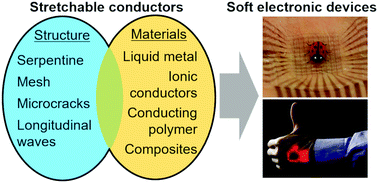
Chem. Soc. Rev., 2019,48, 2946-2966
https://doi.org/10.1039/C8CS00814K
Flexible fiber-based optoelectronics for neural interfaces
Thermally drawn multimaterial fibers were leveraged as multifunctional optoelectronic probes of neural activity and development.
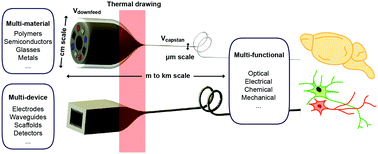
Chem. Soc. Rev., 2019,48, 1826-1852
https://doi.org/10.1039/C8CS00710A
Route towards sustainable smart sensors: ferroelectric polyvinylidene fluoride-based materials and their integration in flexible electronics
Printed ferroelectric devices are ideal candidates for self-powered and multifunctional sensor skins, contributing to a sustainable smart future.

Chem. Soc. Rev., 2019,48, 1787-1825
https://doi.org/10.1039/C8CS00928G
Morphological/nanostructural control toward intrinsically stretchable organic electronics
The development of intrinsically stretchable electronics poses great challenges in synthesizing elastomeric conductors, semiconductors and dielectric materials.
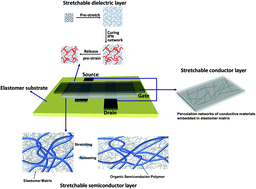
Chem. Soc. Rev., 2019,48, 1741-1786
https://doi.org/10.1039/C8CS00834E
Conductive nanomaterials for 2D and 3D printed flexible electronics
This review describes recent developments in the field of conductive nanomaterials and their application in 2D and 3D printed flexible electronics, with particular emphasis on inks based on metal nanoparticles and nanowires, carbon nanotubes, and graphene sheets.
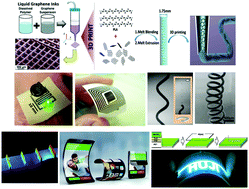
Chem. Soc. Rev., 2019,48, 1712-1740
https://doi.org/10.1039/C8CS00738A
High-performance stretchable conductive nanocomposites: materials, processes, and device applications
This article reviews the cascade strategy of stretchable conductive nanocomposites where various filler materials are processed for stretchable electronic applications.

Chem. Soc. Rev., 2019,48, 1566-1595
https://doi.org/10.1039/C8CS00706C
Softening gold for elastronics
This review covers the latest research progress of “softening” gold materials for various applications in elastronics.

Chem. Soc. Rev., 2019,48, 1668-1711
https://doi.org/10.1039/C8CS00609A
Hydrogel bioelectronics
Hydrogels have emerged as a promising bioelectronic interfacing material. This review discusses the fundamentals and recent advances in hydrogel bioelectronics.

Chem. Soc. Rev., 2019,48, 1642-1667
https://doi.org/10.1039/C8CS00595H
Organic and hybrid resistive switching materials and devices
This review presents a timely and comprehensive summary of organic and hybrid materials for nonvolatile resistive switching memory applications in the “More than Moore” era, with particular attention on their designing principles for electronic property tuning and flexible memory performance.

Chem. Soc. Rev., 2019,48, 1531-1565
https://doi.org/10.1039/C8CS00614H
Organic crystalline materials in flexible electronics
Highly ordered organic crystalline materials provide an ideal platform for next-generation flexible electronics.
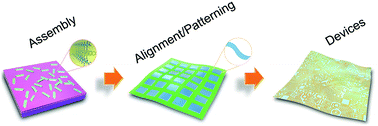
Chem. Soc. Rev., 2019,48, 1492-1530
https://doi.org/10.1039/C8CS00406D
Flexible colloidal nanocrystal electronics
Colloidal nanocrystals are dispersed in solvent forming “inks” for the solution-based fabrication of flexible nanocrystal electronics.

Chem. Soc. Rev., 2019,48, 1626-1641
https://doi.org/10.1039/C8CS00629F
Critical review of the molecular design progress in non-fullerene electron acceptors towards commercially viable organic solar cells
A critical analysis of the molecular design strategies employed in the recent progress of non-fullerene electron acceptors for organic photovoltaics.

Chem. Soc. Rev., 2019,48, 1596-1625
https://doi.org/10.1039/C7CS00892A
Wearable and flexible electronics for continuous molecular monitoring
Wearable/flexible chemical sensors enable continuous molecular monitoring and provide an individual's dynamic health information at the molecular level.
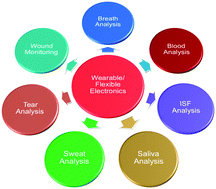
Chem. Soc. Rev., 2019,48, 1465-1491
https://doi.org/10.1039/C7CS00730B
How to tailor flexible silicone elastomers with mechanical integrity: a tutorial review
The tutorial aims to equip the beginners in silicone research with the knowledge to formulate recipes and process elastomer networks, targeting specific properties related to soft applications such as stretchable electronics without compromising the mechanical integrity of the elastomer.
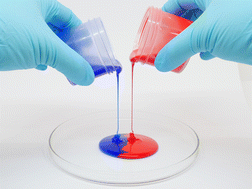
Chem. Soc. Rev., 2019,48, 1448-1464
https://doi.org/10.1039/C8CS00963E
Proactively modulating mechanical behaviors of materials at multiscale for mechano-adaptable devices
Through molecular and structural design, proactively modulated mechano-adaptable devices are shedding light on the next generation of intelligent flexible devices.
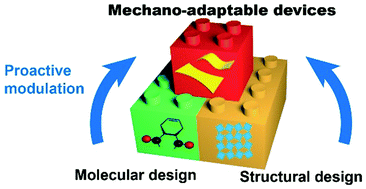
Chem. Soc. Rev., 2019,48, 1434-1447
https://doi.org/10.1039/C8CS00801A
About this collection
We are delighted to present a Chemical Society Reviews themed collection on “Materials chemistry in flexible electronics”, Guest Edited by Xiaodong Chen (Nanyang Technological University), John A. Rogers (Northwestern University), Stéphanie P. Lacour (EPFL), Wenping Hu (Tianjin University) and Dae-Hyeong Kim (Seoul National University). This issue encompasses the recent efforts in materials chemistry to accelerate the research of flexible electronics and highlight the latest development in applications such as electronic skin, healthcare, next generation wearables, display, and energy storage.